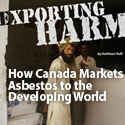Kathleen Ruff, RightOnCanada.ca
An important report, Survey of legislation concerning environmental exposure to asbestos in Quebec and elswhere (translation), released in French by Quebec’s National Public Health Institute, compares environmental laws governing asbestos in Quebec, the other Canadian provinces and territories and at the Canadian national level and those at the US national level and in four US states (California, Maine, Montana and Vermont), as well as the European Union (EU).
The report shows that while laws in the EU, the US at the national level and the four US states studied all designate asbestos as a dangerous substance, in Canada only the federal government and three provinces treat asbestos as a dangerous substance, a pollutant, a contaminant or a toxic substance. In Quebec, asbestos is specifically excluded from Quebec’s regulation on dangerous substances.
While in the EU asbestos is treated as a hazardous waste, less than half the legislation in Canadian provinces treats asbestos as a hazardous or special waste.
Transport of asbestos across borders between provinces, states and countries is considered hazardous by all the jurisdictions studied.
Just over a quarter of laws in Canada contain emission standards governing the emission of asbestos fibres in the ambient or outdoors air.
Canadian legislation weak
The report concludes that Canadian legislation is weaker in dealing with asbestos than that of the US and the EU. The authors hypothesize that the historic exposure to asbestos in the US and the banning of asbestos in Europe could explain in part the adoption of stricter legislation on asbestos in those jurisdictions. On the other hand, notes the report, Canada and more specifically Quebec have been important producers of asbestos in the past, resulting in significant economic consequences and generating important quantities of residues that are difficult to manage.
At a time when the Canadian government is developing new federal regulations to ban asbestos, this report is particularly important and relevant.
In Quebec, the government is moving ahead in approving projects to re-use the residues from its asbestos mines, while having the worst occupational asbestos exposure standards in the Western world and while deliberately and specifically excluding asbestos as a hazardous substance in its environmental regulations .
What is the reason for this exclusion of asbestos as a hazardous substance, asks the report, since it is known that asbestos has serious health impacts such as asbestosis, mesothelioma, cancer of the lung, larynx and ovary? One reason, states the report, may be economic considerations related to the asbestos mining residues.
The impacts on human health that would result from changing the classification of asbestos in Quebec to a hazardous substance deserve to be further explored, concludes the report. This would modify the requirements for controlling and managing the asbestos residues, but could better protect the population during activities to move, bury and re-use these residues.
Quebec’s National Public Health Institute (INSPQ) deserves respect for its integrity and commitment to protect the health of the population of Quebec. In the past, the asbestos lobby has attacked and sought to intimidate and silence the INSPQ and its scientists from putting forward scientific evidence on asbestos, that was unwelcome and inconvenient to the asbestos industry and the government.
They did not succeed in doing so. The INSPQ and the authors of this report are to be commended for publishing this important report.



Thu, Feb 8, 2018
Asbestos